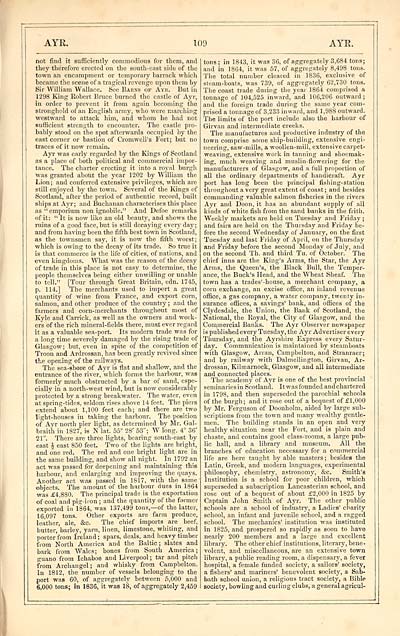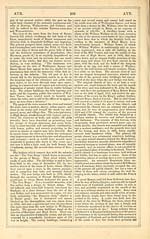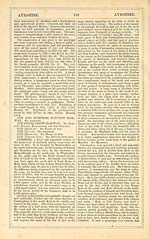Download files
Complete book:
Individual page:
Thumbnail gallery: Grid view | List view

not find it sufficiently commodious for them, and
they therefore erected on the south-cast side of the
town an encampment or temporary barrack which
became the scene of a tragical revenge upon them by
Sir William Wallace. See Barns op Ayr. But in
1298 lung Robert Bruce burned the castle of Ayr,
in order to prevent it from again becoming the
stronghold of an English army, who were marching
westward to attack him, and whom he had not
sufficient strength to encounter. The castle pro-
bably stood on the spot afterwards occupied by the
east corner or bastion of Cromwell's Fort; but no
traces of it now remain.
Ayr was early regarded by the Kings of Scotland
as a place of both political and commercial impor-
tance. The charter erecting it into a royal burgh
was granted about the year 1202 by William the
Lion; and conferred extensive privileges, which are
still enjoyed by the town. Several of the Kings of
Scotland, after the period of authentic record, built
ships at Ayr ; and Buchanan characterises this place
as " emporium non ignobile." And Defoe remarks
of it: " It is now like an old beauty, and shows the
ruins of a good face, but is still decaying every day;
and from having been the fifth best town in Scotland,
as the townsmen say, it is now the fifth worst;
which is owing to the decay of its trade. So true it
is that commerce is the life of cities, of nations, and
even kingdoms. What was the reason of the decay
of trade in this place is not easy to determine, the
people themselves being either unwilling or unable
to tell." [Tour through Great Britain, edn. 1745,
p. 114.] The merchants used to import a great
quantity of wine from France, and export com,
salmon, and other produce of the country ; and the
farmers and corn-merchants throughout most of
Kyle and Carrick, as well as the owner's and work-
ers of the rich mineral-fields there, must ever regard
it as a valuable sea-port. Its modem trade was for
a long time severely damaged by the rising trade of
Glasgow; but, even in spite of the competition of
Troon and Ardrossan, has been greatly revived since
the opening of the railways.
The sea-shore of Ayr is flat and shallow, and the
entrance of the river, which forms the harbour, was
formerly much obstructed by a bar of sand, espe-
cially in a north-west wind, but is now considerably
protected by a strong breakwater. The water, even
at spring-tides, seldom rises above 14 feet. The piers
extend about 1,100 feet each; and there are two
light-houses in taking the harbour. The position
of Ayr north pier light, as determined by Mr. Gal-
braith in 1827, is N lat. 55° 28' 53"; W long. 4° 36'
21". There are three lights, bearing south-east by
east i east 850 feet. Two of the lights are bright,
and one red. The red and one bright light are in
the same building, and show all night. In 1792 an
act was passed for deepening and maintaining this
harbour, and enlarging and improving the quays.
Another act was passed in 1817, with the same
objects. The amount of the harbour dues in 1864
was £4,880. The principal trade is the exportation
of coal and pig-iron ; and the quantity of the former
exported in 1864, was 137,499 tons,— of the latter,
16,097 tons. Other exports are farm produce,
leather, ale, &e. The chief imports are beef,
butter, barley, yarn, linen, limestone, whiting, and
porter from Ireland ; spars, deals, and heavy timber
from North America and the Baltic; slates and
bark from Wales; bones from South America ;
guano from Ichaboe and Liverpool; tar and pitch
from Archangel ; and whisky from Campbelton.
In 1812, the number of vessels belonging to the
port was 60, of aggregately between 5,000 and
6,000 tons; in 1836, it was 18, of aggregately 2,459
tons ; in 1843, it was 36, of aggregately 3,684 tons;
and in 1804, it was 57, of aggregately 8,498 tons.
The total number cleared in 1836, exclusive of
steam-boats, was 739, of aggregately 62,730 tons.
The coast trade during the year 1864 comprised a
tonnage of 104,525 inward, and 106,206 outward;
and the foreign trade during the same year com-
prised a tonnage of 3,233 inward, and 1,988 outward.
The limits of the port include also the harbour of
Girvan and intermediate creeks.
The manufactures and productive industry of the
town comprise some ship-building, extensive engi-
neering, saw-mills, a woollen-mill, extensive carpet-
weaving, extensive work in tanning and shoemak-
ing, much weaving and muslin-flowering for the
manufacturers of Glasgow, and a full proportion of
all the ordinary departments of handicraft. Ayr
port has long been the principal fishing-station
throughout a very great extent of coast ; and besides
commanding valuable salmon fisheries in the rivers
Ayr and Doon, it has an abundant supply of all
kinds of white fish from the sand banks in the frith.
Weekly markets are held on Tuesday and Friday ;
and fairs are held on the Thursday and Friday be-
fore the second Wednesday of January, on the first
Tuesday and last Friday of April, on the Thursday
and Friday before the second Monday of July, and
on the second Th. and third Tu. of October. The
chief inns are the King's Arms, the Star, the Ayr
Arms, the Queen's, the Black Bull, the Temper-
ance, the Buck's Head, and the Wheat Sheaf. The
town has a trades'-house, a merchant company, a
corn exchange, an excise office, an inland revenue
office, a gas company, a water company, twenty in-
surance offices, a savings' bank, and offices of the
Clydesdale, the Union, the Bank of Scotland, the
National, the Royal, the City of Glasgow, and the
Commercial Banks. The Ayr Observer newspaper
is published every Tuesday, the Ayr Advertiser every
Thursday, and the Ayrshire Express every Satur-
day. Communication is maintained by steamboats
with Glasgow, Arran, Campbelton, and Stranraer;
and by railway with Dalmellington, Girvan, Ar-
drossan, Kilmarnock, Glasgow, and all intermediate
and connected places. . .
The academy of Ayr is one of the best provincial
seminariesin Scotland. Itwasfounded andchartered
in 1798, and then superseded the parochial schools
of the burgh; and it rose out of a bequest of £1,000
by Mr. Ferguson of Doonholm, aided by large sub-
scriptions from the town and many wealthy gentle-
men. The building stands in an open and very
healthy situation near the Fort, and is plain and
chaste, and contains good class-rooms, a large pub-
lic hall, and a library and museum. All the
branches of education necessary for a commercial
life are here taught by able masters ; besides the
Latin, Greek, and modern languages, experimental
philosophy, chemistry, astronomy, &c. Smith's
Institution is a school for poor children, which
superseded a subscription Lancasterian school, and
rose out of a bequest of about £2,000 in 1825 by
Captain John Smith of Ayr. The other public
schools are a school of industry, a Ladies' charity
school, an infant and juvenile school, and a ragged
school. The mechanics' institution was instituted
in 1825, and prospered so rapidly as soon to have
nearly 200 members and a large and excellent
library. The other chief institutions, literary, bene-
volent, and miscellaneous, are an extensive town
library, a public reading room, a dispensary, a fever
hospital, a female funded society, a sailors' society,
a fishers' and mariners' benevolent society, a Sab-
bath school union, a religious tract society, a Bible
society, bowling and curling clubs, a general agricul-
they therefore erected on the south-cast side of the
town an encampment or temporary barrack which
became the scene of a tragical revenge upon them by
Sir William Wallace. See Barns op Ayr. But in
1298 lung Robert Bruce burned the castle of Ayr,
in order to prevent it from again becoming the
stronghold of an English army, who were marching
westward to attack him, and whom he had not
sufficient strength to encounter. The castle pro-
bably stood on the spot afterwards occupied by the
east corner or bastion of Cromwell's Fort; but no
traces of it now remain.
Ayr was early regarded by the Kings of Scotland
as a place of both political and commercial impor-
tance. The charter erecting it into a royal burgh
was granted about the year 1202 by William the
Lion; and conferred extensive privileges, which are
still enjoyed by the town. Several of the Kings of
Scotland, after the period of authentic record, built
ships at Ayr ; and Buchanan characterises this place
as " emporium non ignobile." And Defoe remarks
of it: " It is now like an old beauty, and shows the
ruins of a good face, but is still decaying every day;
and from having been the fifth best town in Scotland,
as the townsmen say, it is now the fifth worst;
which is owing to the decay of its trade. So true it
is that commerce is the life of cities, of nations, and
even kingdoms. What was the reason of the decay
of trade in this place is not easy to determine, the
people themselves being either unwilling or unable
to tell." [Tour through Great Britain, edn. 1745,
p. 114.] The merchants used to import a great
quantity of wine from France, and export com,
salmon, and other produce of the country ; and the
farmers and corn-merchants throughout most of
Kyle and Carrick, as well as the owner's and work-
ers of the rich mineral-fields there, must ever regard
it as a valuable sea-port. Its modem trade was for
a long time severely damaged by the rising trade of
Glasgow; but, even in spite of the competition of
Troon and Ardrossan, has been greatly revived since
the opening of the railways.
The sea-shore of Ayr is flat and shallow, and the
entrance of the river, which forms the harbour, was
formerly much obstructed by a bar of sand, espe-
cially in a north-west wind, but is now considerably
protected by a strong breakwater. The water, even
at spring-tides, seldom rises above 14 feet. The piers
extend about 1,100 feet each; and there are two
light-houses in taking the harbour. The position
of Ayr north pier light, as determined by Mr. Gal-
braith in 1827, is N lat. 55° 28' 53"; W long. 4° 36'
21". There are three lights, bearing south-east by
east i east 850 feet. Two of the lights are bright,
and one red. The red and one bright light are in
the same building, and show all night. In 1792 an
act was passed for deepening and maintaining this
harbour, and enlarging and improving the quays.
Another act was passed in 1817, with the same
objects. The amount of the harbour dues in 1864
was £4,880. The principal trade is the exportation
of coal and pig-iron ; and the quantity of the former
exported in 1864, was 137,499 tons,— of the latter,
16,097 tons. Other exports are farm produce,
leather, ale, &e. The chief imports are beef,
butter, barley, yarn, linen, limestone, whiting, and
porter from Ireland ; spars, deals, and heavy timber
from North America and the Baltic; slates and
bark from Wales; bones from South America ;
guano from Ichaboe and Liverpool; tar and pitch
from Archangel ; and whisky from Campbelton.
In 1812, the number of vessels belonging to the
port was 60, of aggregately between 5,000 and
6,000 tons; in 1836, it was 18, of aggregately 2,459
tons ; in 1843, it was 36, of aggregately 3,684 tons;
and in 1804, it was 57, of aggregately 8,498 tons.
The total number cleared in 1836, exclusive of
steam-boats, was 739, of aggregately 62,730 tons.
The coast trade during the year 1864 comprised a
tonnage of 104,525 inward, and 106,206 outward;
and the foreign trade during the same year com-
prised a tonnage of 3,233 inward, and 1,988 outward.
The limits of the port include also the harbour of
Girvan and intermediate creeks.
The manufactures and productive industry of the
town comprise some ship-building, extensive engi-
neering, saw-mills, a woollen-mill, extensive carpet-
weaving, extensive work in tanning and shoemak-
ing, much weaving and muslin-flowering for the
manufacturers of Glasgow, and a full proportion of
all the ordinary departments of handicraft. Ayr
port has long been the principal fishing-station
throughout a very great extent of coast ; and besides
commanding valuable salmon fisheries in the rivers
Ayr and Doon, it has an abundant supply of all
kinds of white fish from the sand banks in the frith.
Weekly markets are held on Tuesday and Friday ;
and fairs are held on the Thursday and Friday be-
fore the second Wednesday of January, on the first
Tuesday and last Friday of April, on the Thursday
and Friday before the second Monday of July, and
on the second Th. and third Tu. of October. The
chief inns are the King's Arms, the Star, the Ayr
Arms, the Queen's, the Black Bull, the Temper-
ance, the Buck's Head, and the Wheat Sheaf. The
town has a trades'-house, a merchant company, a
corn exchange, an excise office, an inland revenue
office, a gas company, a water company, twenty in-
surance offices, a savings' bank, and offices of the
Clydesdale, the Union, the Bank of Scotland, the
National, the Royal, the City of Glasgow, and the
Commercial Banks. The Ayr Observer newspaper
is published every Tuesday, the Ayr Advertiser every
Thursday, and the Ayrshire Express every Satur-
day. Communication is maintained by steamboats
with Glasgow, Arran, Campbelton, and Stranraer;
and by railway with Dalmellington, Girvan, Ar-
drossan, Kilmarnock, Glasgow, and all intermediate
and connected places. . .
The academy of Ayr is one of the best provincial
seminariesin Scotland. Itwasfounded andchartered
in 1798, and then superseded the parochial schools
of the burgh; and it rose out of a bequest of £1,000
by Mr. Ferguson of Doonholm, aided by large sub-
scriptions from the town and many wealthy gentle-
men. The building stands in an open and very
healthy situation near the Fort, and is plain and
chaste, and contains good class-rooms, a large pub-
lic hall, and a library and museum. All the
branches of education necessary for a commercial
life are here taught by able masters ; besides the
Latin, Greek, and modern languages, experimental
philosophy, chemistry, astronomy, &c. Smith's
Institution is a school for poor children, which
superseded a subscription Lancasterian school, and
rose out of a bequest of about £2,000 in 1825 by
Captain John Smith of Ayr. The other public
schools are a school of industry, a Ladies' charity
school, an infant and juvenile school, and a ragged
school. The mechanics' institution was instituted
in 1825, and prospered so rapidly as soon to have
nearly 200 members and a large and excellent
library. The other chief institutions, literary, bene-
volent, and miscellaneous, are an extensive town
library, a public reading room, a dispensary, a fever
hospital, a female funded society, a sailors' society,
a fishers' and mariners' benevolent society, a Sab-
bath school union, a religious tract society, a Bible
society, bowling and curling clubs, a general agricul-
Set display mode to: Large image | Transcription
Images and transcriptions on this page, including medium image downloads, may be used under the Creative Commons Attribution 4.0 International Licence unless otherwise stated. ![]()
| Gazetteers of Scotland, 1803-1901 > Imperial gazeteer of Scotland, or, Dictionary of Scottish topography > Volume 1 > (201) Page 109 |
|---|
| Permanent URL | https://digital.nls.uk/97461542 |
|---|
| Description | Volume I: Aan-Gordon. |
|---|---|
| Attribution and copyright: |
|

